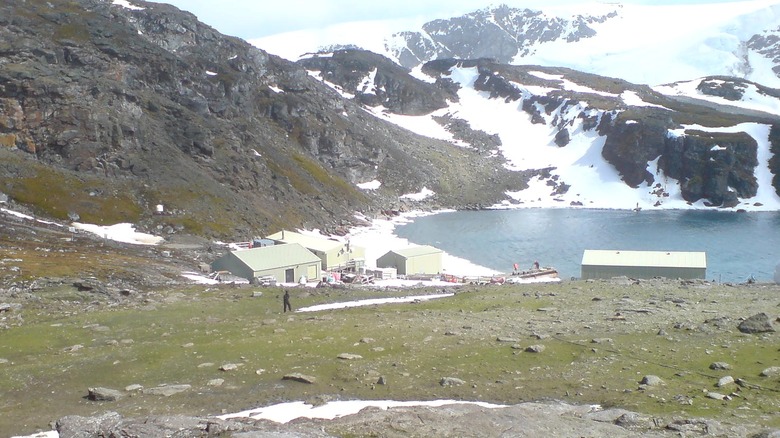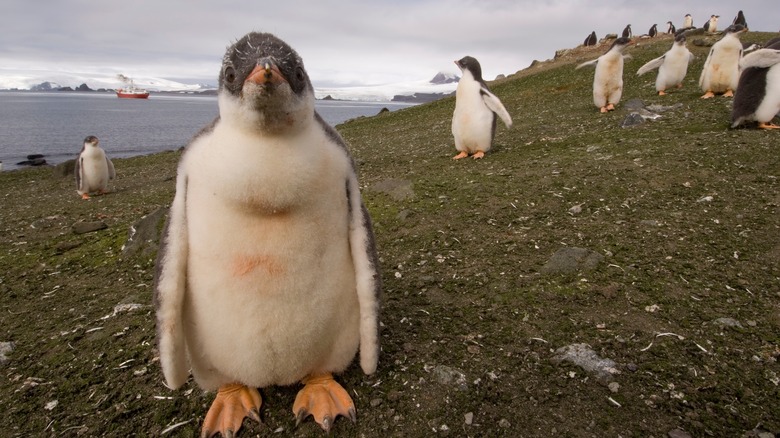The Alarming Reason Flowers Are Blooming In Antarctica
Few of us have been to Antarctica, but most of us have a pretty accurate idea of what it's like there. It's cold, mostly frozen, and barren of life save for hardy penguins, tiny aquatic drifters, and other elusive extremophiles — and it's certainly not known for its greenery. That's why the recent news of unprecedented amounts of flowers blooming on the icy continent is such an alarming discovery.
If you guessed the reason behind this floral bloom to be climate change, you guessed right. A 2022 research study published in Current Biology observed the increasing propagation of two native flowering plants over the past decade. The joint research team went on to present evidence suggesting that rising summer temperatures were the main culprit.
The plants studied are native species to Antarctica, but their population size and bloom patterns have noticeably increased. In fact, the data suggests not only an increase but an acceleration of their foothold among the rocky landscape and melting ice of Antarctica's Signy Island. In such a historically inhospitable ecosystem, fields of flowers are both beautiful and worrying.
[Featured image by Ben Tullis via Wikimedia Commons | Cropped and scaled | CC BY 2.0]
The flowers flourishing in Antarctica
There are only two flowering plants native to Antarctica: the Antarctic Hair Grass and the Antarctic Pearlwort. Researchers first began collecting data on these two unique plants in 1960, and a slow and steady increase in growth was clearly observed over the decades. However, scientists comparing the data noticed the growth rate had accelerated five-fold in the period between 2009 and 2018.
The plants themselves are well adapted to Antarctica's harsh climate. The Antarctic Hair Grass (Deschampsia antarctica) is hardy in the face of strong winds, long periods of little sunlight, and the frigid temperatures that define the region. Part of the Poaceae family of plants, it's indeed a grass, with thin, hairy leaves and tiny florets. It's far from a rose bush, but its tufted leaves add green to an otherwise white and grey landscape. Though equipped to endure extreme weather, the Antarctic Hair Grass is vulnerable to trampling by animals. In fact, declining numbers of fur seal visitors to the island is suspected to be another reason for the plant's recent boom in blooms. The decrease in fur seal populations is also likely a consequence of global warming, so the main culprit for the blooms is still, ultimately, a changing climate.
The other endemic flowering plant to Antarctica is the Antarctic Pearlwort (Colobanthus quitensis), which, subjectively speaking, produces much more eye-catching flowers than its hairy cohabitant. The Pearlwort's flowers are small but numerous, with colors ranging between white, yellow, and pink. Its green base and colorful flowers were once a rare and curious sight in Antarctica, but as the ice melts away and real estate opens up, the Pearlwort is gaining ground.
[Featured image by Liam Quinn via Wikimedia Commons | Cropped and scaled | CC BY 2.0]
What makes Antarctica so inhospitable – and how that's changing
Antarctica wasn't always a frozen desert. 200 million years ago, it was still part of the supercontinent Gondwana, where you could find a lush landscape of trees, animals, ferns — and possibly even the ancestors of our modern world's flowering plants. But thanks to continental drift and shifts in the global climate, the landmass separated from the other continents, settled around the South Pole, and froze over. By around 23 million years ago, some plants and animals still remained; around 15 million years ago, the entire continent had transformed into a frozen desert.
And so Antarctica became inhospitable to all but the hardiest organisms. Besides widely variable temperatures, there are also strong winds, extreme pH levels, low precipitation, near-zero oxygen levels in the frozen soil, and intense radiation from the thinness of the ozone layer. Such brutal conditions are the reason any organisms able to survive in Antarctica are called extremophiles.
Considering the challenges, however, the biodiversity of Antarctica is surprisingly rich. Antarctica is home to iconic birds like penguins, albatross, prions, and petrels. Besides the birds, numerous arthropods, worms, and micro-invertebrates inhabit the frozen terrain. Seals slip from the land to the sea, joining whales, fish, squid, krill, and a bounty of other aquatic creatures. Beyond the animal kingdom, scores of lichens, fungi, liverworts, and mosses have carved out a living. But only two species of flowering plants are endemic to Antarctica. Their range is limited to the South Shetland Islands, the western peninsula, and the South Orkney Islands — areas farther from the pole, where the ice sheets aren't so thick. However, the effects of global warming can be felt across the entire continent.
How climate change is boosting floral blooms in Antarctica
It's easy to assume that global warming melts the ice and uncovers new terrain for plants to take root, but that's only part of the equation. Indeed, the rising temperatures are expanding real estate for plants, a trend with no signs of stopping. However, according to the research, the main driver of accelerated plant growth is warmer summers. The net increase of summer temperatures by 1 degree Celsius since 1960 appears to have directly encouraged faster growth rates. Essentially, the evidence suggests that higher temperatures could accelerate seed production, pollen quality, and sexual reproduction in both plant species. The researchers also demonstrated the plants experienced "enhanced photosynthetic assimilation, higher leaf carbon gain and plant growth" in warmer temperatures (via Current Biology).
The second major cause of the plants' propagation is believed to be a decrease in fur seal activity. In the past, large populations of fur seals trampled a significant portion of the flowering plants, limiting their range to areas untrodden by the galumphing megafauna. As the paper points out, the fur seal population made a large comeback in the 1970s and '80s after their over-exploitation was curtailed.
However, in recent years, it seems the seals have been visiting the island at unpredictable rates — rates which may even be declining overall. It's possible this decline is directly related to climate change, as a 2009 study in Polar Biology points out that fast-ice along the shores began breaking off later in the year, delaying the start of the breeding season and discouraging fur seals to establish a population on Signy Island. For the Antarctic Pearlwort and the Antarctic Hair Grass, this is good news, but it paints an alarming picture of the future of Antarctica's delicate ecosystem.



